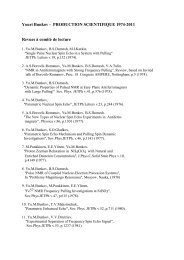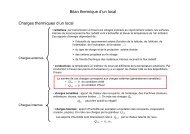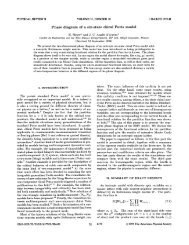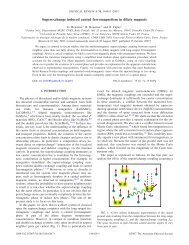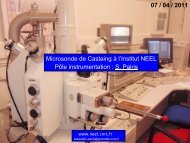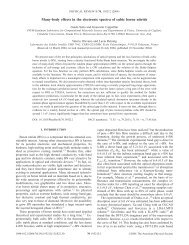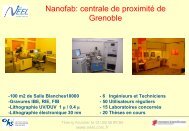Book of abstracts - Euro-MBE 2011 - CNRS
Book of abstracts - Euro-MBE 2011 - CNRS
Book of abstracts - Euro-MBE 2011 - CNRS
Create successful ePaper yourself
Turn your PDF publications into a flip-book with our unique Google optimized e-Paper software.
Mo1.3<br />
200 mm GaAs wafers by <strong>MBE</strong> on SGOI and Ge/Si substrates<br />
M. Richter 1,* , T. Topuria 2 , C. Marchiori 1 , M. El-Kazzi 1 , C. Rossel 1 , C. Gerl 1 , D.J. Webb 1 ,<br />
T. Smets 3 , C. Andersson 1 , M. Sousa 1 , D. Caimi 1 , L. Czornomaz 1 , H. Siegwart 1 ,<br />
J.-F. Damlencourt 4 , J.-M. Hartmann 4 , P.M. Rice 2 , and J. Fompeyrine 1<br />
1<br />
IBM Research – Zurich, Säumerstrasse 4, 8803 Rüschlikon, Switzerland<br />
2 IBM Research – Almaden, 650 Harry Road, San Jose, California, USA<br />
3 Kath. Uni. Leuven – Celestijnenlaan 200D, 3001 Heverlee, Belgium<br />
4 CEA-LETI – Grenoble, 17 rue des Martyrs, 38054 Grenoble, France<br />
The use <strong>of</strong> production size wafers is a prerequisite for the integration <strong>of</strong> III-V materials in future<br />
CMOS technology. Besides obvious technical benefits to merge III-V with silicon process technology,<br />
it also allows to economize on scarce materials. In this presentation, GaAs heterogeneous integration<br />
on 200 mm Si and SGOI wafers via Ge buffers will be discussed.<br />
In our previous work, we have studied thin (≤ 250 nm) <strong>MBE</strong>-grown Ge buffers. This had the<br />
advantage to rely on the use <strong>of</strong> two UHV-connected <strong>MBE</strong> chambers, thus limiting air exposure<br />
between Ge buffer and GaAs growth [1]. In this paper, we discuss an alternative approach which<br />
consists in combining Ge growth by reduced pressure-chemical vapor deposition (RP-CVD) with<br />
subsequent, ex-situ <strong>MBE</strong> GaAs deposition. CVD growth allows for thicker Ge layers and anneals in<br />
the H 2 carrier gas. By this means reduced defect densities [2] and flatter surfaces due to the surfactant<br />
action <strong>of</strong> H 2 [3] can be achieved. In a first series <strong>of</strong> samples, we use 200 mm Si(001) wafers with 1.5<br />
µm Ge. In a second series <strong>of</strong> sample, we use 200 mm SGOI wafers, which feature improved insulation<br />
to the Si substrate and optional co-integration <strong>of</strong> fully depleted GOI p-FETs [4].<br />
Special care needs to be taken to clean the Ge/Si or SGOI wafers before the GaAs <strong>MBE</strong> growth. The<br />
anneal temperature should be minimized to take account <strong>of</strong> the limited temperature stability. All<br />
wafers were prepared with an HF-dip as last cleaning step. Then, they were either exposed to a remote<br />
hydrogen plasma [5] or annealed at 600 °C in UHV. The removal <strong>of</strong> oxides and carbon was monitored<br />
with x-ray photoelectron spectroscopy (XPS). The H plasma efficiently removes oxide species at<br />
temperatures as low as 250 °C on both Ge/Si and SGOI substrates (spectra in Fig. 1). Only traces <strong>of</strong> C<br />
contamination are observed after such cleaning treatment. As opposed to that, after sample flash<br />
substantial amounts <strong>of</strong> SiOx are observed (Fig. 1(b)).<br />
For the SGOI wafers, either 200 nm Ge were deposited in a UHV-connected Si/Ge <strong>MBE</strong> system or<br />
SGOI wafers capped with 20 nm CVD-grown Ge were used. Then, the wafers were directly<br />
transferred under UHV conditions for epitaxy <strong>of</strong> 500 nm GaAs. Fig. 2 shows corresponding reflection<br />
high energetic electron diffraction (RHEED) images after the individual steps.<br />
We will discuss the impact <strong>of</strong> the substrate, its cleaning and <strong>of</strong> the different buffers on the GaAs<br />
structural quality. Cross-sectional transmission electron microscopy (XTEM) and atomic force<br />
microscope (AFM) images <strong>of</strong> a first sample <strong>of</strong> 500 nm GaAs on 20 nm Ge CVD-capped SGOI are<br />
shown in Fig. 3 (a) and (b), respectively.<br />
TEM specimen preparation by L.M. Clark and L.E. Krupp (IBM Research - Almaden) as well as<br />
financial support by the <strong>Euro</strong>pean Commission in frame <strong>of</strong> the FP7 project DUALLOGIC is gratefully<br />
acknowledged.<br />
[1] M. Richter, C. Rossel, D.J. Webb, T. Topuria, C. Gerl, M. Sousa, C. Marchiori, D. Caimi, H. Siegwart, P.M. Rice and J.<br />
Fompeyrine, “GaAs on 200 mm Si wafers via thin temperature graded Ge buffers by molecular beam epitaxy” submitted to J.<br />
Cryst. Growth and abstract <strong>MBE</strong> 2010 conference.<br />
[2] J.M. Hartmann, A. Abbadie, N. Cherkashin, H. Grampeix, and L. Clavelier, Semicond. Sci. Technol., 24, 055002 (2009).<br />
[3] L. Colace, G. Masini, F. Galluzzi, G. Assanto, G. Capellini, L. Di Gaspare, E. Palange, and F. Evangelisti, Appl. Phys.<br />
Lett., 72, 3175 (1998).<br />
[4] W. Van Den Daele, E. Augendre, K. Romanjek, C. Le Royer, L. Clavelier, J.-F. Damlencourt, E. Guiot, B. Ghyselen, and<br />
S. Cristoloveanu, ECS Trans., 19, 145 (2009).<br />
[5] C. Marchiori, D. J. Webb, C. Rossel, M. Richter, M. Sousa, C. Gerl, R. Germann, C. Andersson, and J. Fompeyrine, J.<br />
Appl. Phys., 106, 114112 (2009).<br />
__________________________<br />
* Contact: mri@zurich.ibm.com



